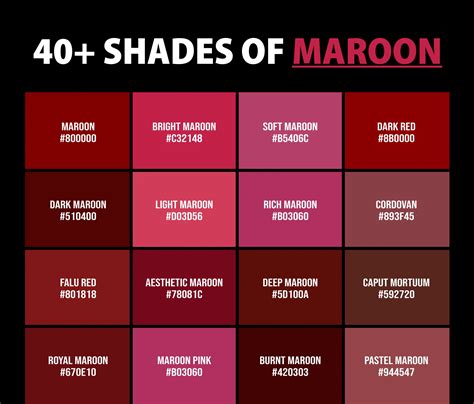Introduction

Maroon and burgundy have often been mistaken for each other, due to their similar appearance. However, there are definite differences between the two colors that make them stand out as unique hues. This guide will delve into the history, applications, and distinct characteristics of maroon and burgundy, providing a comprehensive comparison to help you understand their nuances.
Origins and History
1. Maroon:
- Originated from the French word “marron,” meaning “chestnut”
- First used in the 16th century to describe the color of ripe chestnuts
- Initially associated with academic robes and official seals
2. Burgundy:
- Named after the Burgundy region in France, famous for its red wines
- Originally referred to the shade of the wine produced in the region
- Gained popularity in fashion and interior design in the 19th century
Color Characteristics
1. Maroon:
- A dark shade of red with a brownish tint
- Hex color code: #800020
- RGB values: 128, 0, 32
2. Burgundy:
- A deep, rich red with a purple or violet hue
- Hex color code: #800040
- RGB values: 128, 0, 64
Applications
Fashion:
- Maroon: Often used in formal attire, sportswear, and military uniforms
- Burgundy: Popular in evening wear, wine accessories, and scarves
Interior Design:
- Maroon: Creates a warm and cozy atmosphere, suitable for living rooms and bedrooms
- Burgundy: Adds elegance and sophistication to spaces, often paired with gold or cream accents
Other Applications:
- Maroon: Used in food coloring and wine production
- Burgundy: Found in certain cosmetics, such as lipsticks and nail polishes
Cultural Significance
1. Burgundy:
- Traditionally associated with wealth and nobility in Europe
- Often used as the color of royal robes and official documents
2. Maroon:
- Symbolizes courage and bravery in military uniforms
- Used as the school color for several prestigious universities
Distinctive Features
1. Warmth: Maroon tends to have a warmer undertone due to its brown tint, while burgundy is cooler due to its purple hue.
2. Intensity: Burgundy is generally a more intense color than maroon, with a deeper and richer tone.
3. Versatility: Both maroon and burgundy can be paired with various colors to create different aesthetic effects. Maroon pairs well with neutrals, while burgundy complements both cold and warm tones.
Practical Considerations
1. Pairing Considerations: Maroon is suitable for warmer color schemes and casual settings, while burgundy adds sophistication to formal occasions and cooler décor.
2. Lighting: The appearance of maroon and burgundy can change under different lighting conditions. Maroon tends to appear darker in low light, while burgundy retains its richness.
Benefits of Maroon and Burgundy
1. Maroon:
- Creates a warm and inviting atmosphere
- Conveys professionalism and stability
- Suitable for casual and formal settings
2. Burgundy:
- Adds elegance and sophistication
- Symbolizes luxury and opulence
- Pairs well with a wide range of colors
Strategies for Using Maroon and Burgundy
1. Color Combinations:
- Maroon: Pair with cream, beige, or gold for a cozy look
- Burgundy: Combine with navy, gray, or ivory for a sophisticated style
2. Patterns and Textures:
- Use subtle patterns or textures in maroon or burgundy to add interest
- Consider velvet or silk fabrics for a luxurious touch
3. Lighting: Ensure proper lighting to showcase the richness of both hues
– Use natural light or warm incandescent bulbs for optimal results
Conclusion
Maroon and burgundy may be similar in appearance, but their distinct characteristics make them unique and versatile colors. By understanding the origins, applications, and nuances of each shade, you can harness their power to create stunning visual effects and convey desired messages. Whether used in fashion, interior design, or other applications, maroon and burgundy continue to captivate and inspire, offering timeless elegance and a touch of sophistication.
